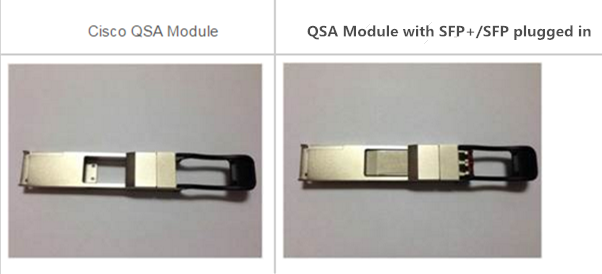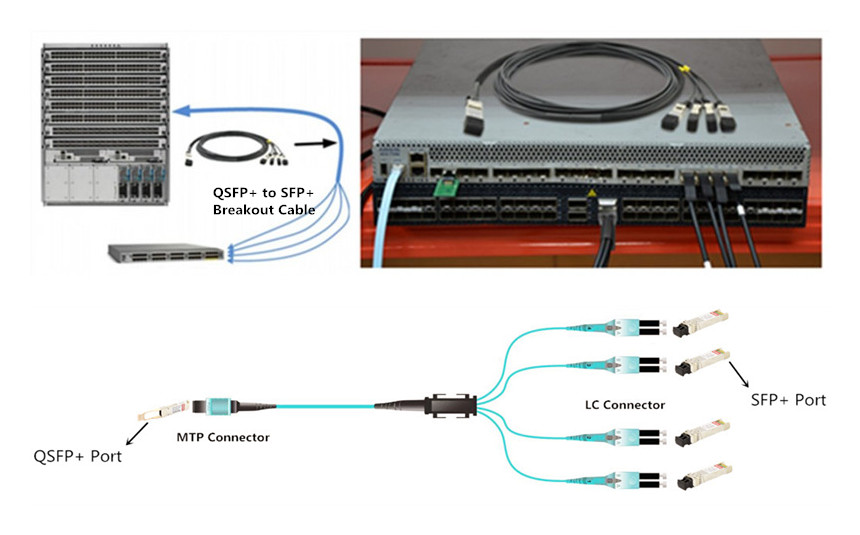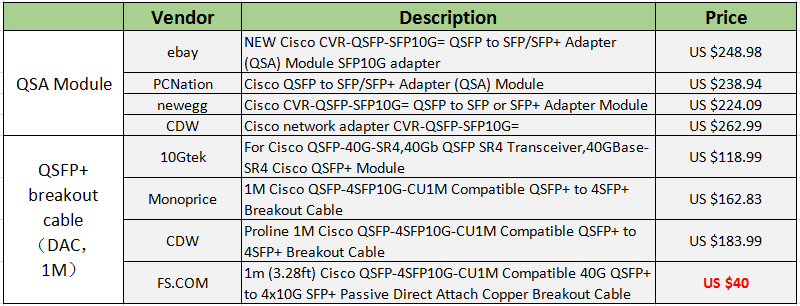QSFP+ to SFP+ Adapter (QSA) Module Vs. QSFP+ to SFP+ Breakout Cable
People frequently ask about feasible solutions between 10G and 40G servers. QSFP+ breakout cables like QSFP+ to 4 SFP+ cables and MTP to 4 LC harness cables are the commonly used equipment to connect between QSFP+ ports and SFP+ ports. But recently, Cisco launched a new type of product—QSFP+ to SFP+ Adapter (QSA) module that could provide a smooth migration to 40 Gigabit Ethernet. Is it a better solution for the 10G to 40G migration? Should I use the QSA module or 40G QSFP+ breakout cable? This article will answer the above questions and provide some suggestions to you.
QSA Module—Is It a Better Solution for the 40G Migration?
The QSFP+ to SFP+ Adapter module, specified by Cisco, is the module built in QSFP+ form factor with a receptacle for SFP+ cable connector at the back (seen in the below image). When connecting the QSFP port to an SFP+ port, QSA module usually acts as an interface for SFP+/SFP cables. That means you can effectively plug in an SFP+/SFP optics operating at a 10 Gbps port on this module, then inserting the module into a QSFP port cage to realize the 40G Ethernet transition. QSFP+ to SFP+ adapter module ensures the smooth connectivity between 40 Gigabit Ethernet adapter and 10 Gigabit hardware using SFP+ based cabling. Therefore, once the QSA module came out in 2016, it was soon considered as the effective solutions for converting 40G ports to the 10G ports.

40G QSFP+ Breakout Cables Overview
People usually use either the QSFP+ to 4 SFP+ breakout cables or MTP to LC harness cables to convert the downlink 40G port of ToR (Top of Rack) access layer switch into 4x10G fan out mode, then connect to the 10G cabinet server port. QSFP+ to SFP+ breakout cable including the direct attach copper cable (DAC) and active optical cable (AOC) consists of a QSFP+ connector on one end and four SFP+ connectors on the other end. The cables use high-performance integrated duplex serial data links for bidirectional communication on four links simultaneously.

While the MTP to LC harness cable have one one MTP cables on the one end and four LC connectors on the other end. This type of cable is recommended to be used in the same rack within the short distance. The picture above shows the direct connectivity between the QSFP+ transceivers and SFP+ transceivers by using the MTP to LC harness cable.
QSA Module or QSFP+ Breakout Cable
In this part, I will make a comparison between QSFP+ to SFP+ adapter modules and QSFP+ breakout cables from the aspects of cost, performance and compatibility.
Cost—QSFP+ Breakout Cables Wins
QSFP+ to SFP+ adapter module is not certificated by Multi-source Agreement (MSA), but a sole source paradigm defined by few vendors. The only vendor owns its patent, so the QSA modules on the market are quite expensive. Nevertheless, QSFP+ breakout cables covered in the MSA standard, support both copper and optical connectivity, which are much cheaper than QSA modules. Cost comparison between QSA module and QSFP+ breakout cable (DAC, 1m) is listed in the below table.

Performance
With QSA module, users have the flexibility to use any SFP+/SFP optics to connect to the 40Gbps data rate with a single 10G connection. However, QSA module only exists in 10G-40G speed, which also explains the reasons of its unpopularity of the market. QSFP+ to 4 SFP+ breakout cables split the 40G channel into 4x10G channel which provide four times more data transfers than QSA module does.
Compatible Switch and SFP/SFP+ Modules
QSA modules, according to Cisco, are available in 40 Gigabit Ethernet compatibility matrix. Cisco SFP/SFP+ transceivers that can be plugged into the QSA modules are concluded as Cisco 10GBASE-SR, LR, ER, ZR, DWDM SFP+, FET-10G and 10G SFP+ cable as well as SFP (1000BASE-T, SX, LX, EX, ZX). As for the QSFP+ to SFP+ breakout cables, different vendors have different compatible issues. Keep in mind that you should find the reliable fiber optic transceiver manufacturers.
Reminder:
- Before using the QSA modules or the QSFP+ breakout cables to connect a 40 Gigabit Ethernet port to a 10 Gigabit SFP+ port, you must enable the fan-out mode of your devices.
- Not all the 40G cards and switches can be split into 4x 10Gb mode, for example, the Mellanox QSFP cards do not support the QSFP to SFP+ breakout, but their switches can.
- With the QSA module, you can directly use the SFP+ modules in a QSFP+ port, but you cannot use the QSFP+ optical cables in a QSA setup.
- Telecom industry has been modified rapidly. Hence, it is more cost-effective to make additional investment in high-speed switches instead of breakout cables and expensive QSA modules.
Conclusion
Both the QSFP+ breakout cables and QSA modules provide a smooth migration to the 40 Gigabit Ethernet. With these optics, you can reuse the existing 10G SFP+ cables, optical transceivers and switches when upgrading to 40G Ethernet. QSFP+ breakout cables is regarded as the cost-effective and reliable solutions for the most situations, but QSA module is preferable for the application with a single 10G connection.
Original source: QSA Module Vs. QSFP+ to SFP+ Breakout Cable – Chinacablebuy

Comments